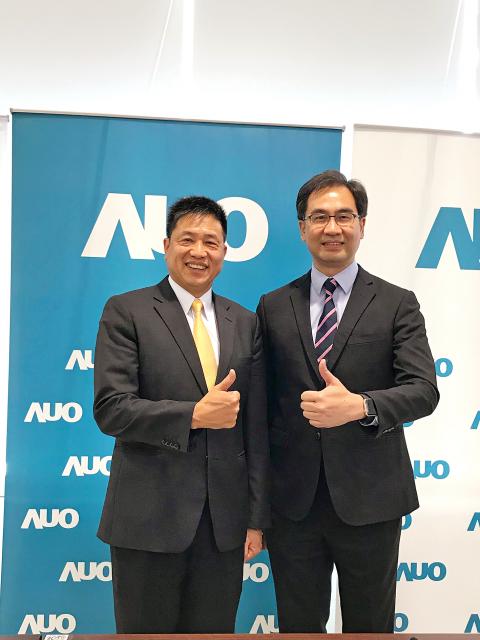AU Optronics Corp (AUO, 友達光電), the nation’s second-largest LCD panel maker, expects the downward pressure on prices of LCD TV panels to ease in the second half of this year, thanks to improving inventories and rising demand ahead of the peak season.
Since the beginning of this year, prices for TV panels, such as 32-inch and 40-inch screens, have dropped more than 20 percent, as TV vendors continued to scale down orders to level off their excessive stockpiles, the company said.
“It is unlikely that panel prices will hover at below-cost levels for a long period. The market will balance out eventually,” AUO chairman Paul Peng (彭双浪) told a media briefing after the company’s annual shareholders’ meeting in Taichung on Friday last week.

Photo: Chen Mei-ying, Taipei Times
As the LCD TV market is to enter its peak season in the third and fourth quarters, price declines should slow and the price of certain types of panels might even pick up, Peng said.
The ongoing FIFA World Cup would help stimulate TV sales, while most TV vendors are close to reducing their panel inventories to healthy levels, he said.
Those favorable factors would help boost AUO’s business in the second half of the year, he added.
Commenting on the competition from Chinese peers, Peng said that AUO has been developing panels with added value, such as those used in cars and the commercial sector, which would enable the company to better manage downturns and price competition.
Revenue from panels used in cars is predicted to grow by a double-digit percentage this year, as automakers are equipping new car models with bigger screens of 12 to 13 inches, Peng said.
More than half of the company’s revenue is generated by value-added panels, he said.
The company’s healthy financial status would give AUO more leeway to cope with escalating competition, Peng said.
AUO last year saw its net profit grow to a 10-year high of NT$32.36 billion (US$1.08 billion). The company reduced its net debt ratio to 4.8 percent last quarter, from 18.5 percent a year earlier, the company’s financial statement showed. It has accumulated NT$97.12 billion in cash and cash equivalents.
As for products, AUO said it would ship its first mini-LED panels — which are used in premium monitors for gaming PCs — in the second half of the year.
After that, it is scheduled to ship mini-LED panels used in notebook computers, the company said, adding that it is also developing mini-LED panels for mobile phones and virtual-reality devices.
Mini-LED panels have a similar brightness, color contrast and response time to OLED panels, but at more affordable prices.
AUO shareholders on Friday approved the distribution of a cash dividend of NT$1.5 per common share, which represented a payout ratio of 44.64 percent, based on earnings per share of NT$3.36 last year.

UNCERTAINTY: Innolux activated a stringent supply chain management mechanism, as it did during the COVID-19 pandemic, to ensure optimal inventory levels for customers Flat-panel display makers AUO Corp (友達) and Innolux Corp (群創) yesterday said that about 12 to 20 percent of their display business is at risk of potential US tariffs and that they would relocate production or shipment destinations to mitigate the levies’ effects. US tariffs would have a direct impact of US$200 million on AUO’s revenue, company chairman Paul Peng (彭雙浪) told reporters on the sidelines of the Touch Taiwan trade show in Taipei yesterday. That would make up about 12 percent of the company’s overall revenue. To cope with the tariff uncertainty, AUO plans to allocate its production to manufacturing facilities in

TAKING STOCK: A Taiwanese cookware firm in Vietnam urged customers to assess inventory or place orders early so shipments can reach the US while tariffs are paused Taiwanese businesses in Vietnam are exploring alternatives after the White House imposed a 46 percent import duty on Vietnamese goods, following US President Donald Trump’s announcement of “reciprocal” tariffs on the US’ trading partners. Lo Shih-liang (羅世良), chairman of Brico Industry Co (裕茂工業), a Taiwanese company that manufactures cast iron cookware and stove components in Vietnam, said that more than 40 percent of his business was tied to the US market, describing the constant US policy shifts as an emotional roller coaster. “I work during the day and stay up all night watching the news. I’ve been following US news until 3am

COLLABORATION: Given Taiwan’s key position in global supply chains, the US firm is discussing strategies with local partners and clients to deal with global uncertainties Advanced Micro Devices Inc (AMD) yesterday said it is meeting with local ecosystem partners, including Taiwan Semiconductor Manufacturing Co (TSMC, 台積電), to discuss strategies, including long-term manufacturing, to navigate uncertainties such as US tariffs, as Taiwan occupies an important position in global supply chains. AMD chief executive officer Lisa Su (蘇姿丰) told reporters that Taiwan is an important part of the chip designer’s ecosystem and she is discussing with partners and customers in Taiwan to forge strong collaborations on different areas during this critical period. AMD has just become the first artificial-intelligence (AI) server chip customer of TSMC to utilize its advanced

Six years ago, LVMH’s billionaire CEO Bernard Arnault and US President Donald Trump cut the blue ribbon on a factory in rural Texas that would make designer handbags for Louis Vuitton, one of the world’s best-known luxury brands. However, since the high-profile opening, the factory has faced a host of problems limiting production, 11 former Louis Vuitton employees said. The site has consistently ranked among the worst-performing for Louis Vuitton globally, “significantly” underperforming other facilities, said three former Louis Vuitton workers and a senior industry source, who cited internal rankings shared with staff. The plant’s problems — which have not